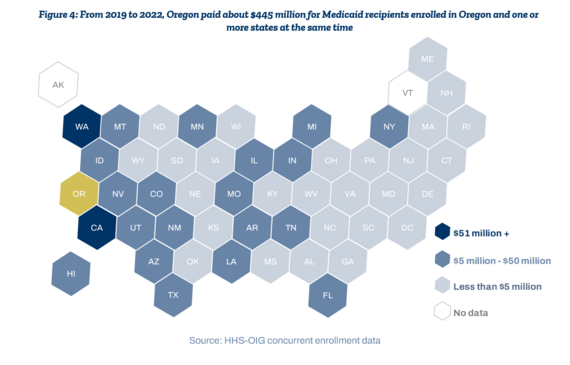 Oregon Audits Division releases collaborative audit of Medicaid concurrent enrollment with Washington State Auditor, HHS-OIG
SALEM, OR — In an innovative partnership to leverage audit work across multiple states and ultimately save taxpayer money, the Oregon Audits Division today released an audit examining Medicaid concurrent enrollment in Oregon and Washington.
The audit was a collaborative effort among the Oregon Secretary of State Audits Division, the Office of the Washington State Auditor, and the U.S. Department of Health and Human Services Office of Inspector General (HHS-OIG).
While many states have partnered with HHS-OIG to analyze Medicaid enrollment, today’s audit is the only time two states have partnered to do a deeper dive on Medicaid data around concurrent enrollment.
“The results of this audit analysis are enormously beneficial. Reducing concurrent enrollment does not eliminate anyone’s Medicaid benefits, it simply eliminates a wasteful duplicate payment,” said Oregon Secretary of State LaVonne Griffin-Valade. “I want to thank our partners in the Washington State Auditor’s Office, and the Health and Human Services Office of Inspector General, for their assistance with this unique and innovative audit work. Both Oregonians and Washingtonians benefit from this kind of collaboration.”
“This collaborative approach offers both Washington and Oregon an opportunity to ensure people receive the care they need, while preventing unnecessary costs to our health care systems,” said Washington State Auditor Pat McCarthy. “Together with the insightful work of our colleagues in the Oregon Audit Division, we have made an especially valuable contribution to our federal partner’s understanding of how and why concurrent enrollment happens.”
Medicaid is one of the largest and most expensive government programs, serving more than 1.4 million Oregonians in 2024 and spending more than one third of the state budget. Auditors conducted data analysis to identify instances of concurrent enrollment — that is, when a person is enrolled in Medicaid in multiple states at the same time and receiving duplicate benefits.
Auditors found Oregon paid $65 million in Medicaid benefits for recipients who were also receiving benefits in Washington from 2019 to 2022. In that same time frame, Oregon also paid $134 million in Medicaid benefits to recipients also receiving benefits from California. In total, Oregon paid $445 million for concurrent Medicaid enrollments across dozens of states.
 That’s not to say all $445 million in payments was improper. Further analysis would be needed to determine whether it was appropriate for Oregon to pay these benefits, or whether it should be another state, depending on where the recipient was living at the time.
Making these determinations can be challenging. For example, many people live along the border of Oregon and Washington and move frequently between states. Auditors tested a sample of 100 Medicaid recipients receiving benefits from Oregon and verified 34 of them were residing in Oregon — and therefore it was appropriate for Oregon to pay for these benefits — while 38 of them were residing in Washington, meaning Oregon’s payment for benefits was redundant. Auditors estimated the potential for $29 million in improper payments based on this testing with Washington.
Despite these findings, one major hurdle stands in the way of states being able to do this type of analysis and prevent improper payments: not enough federal support. The federal government relies on individual states to identify concurrent enrollments, but states are not provided with data that HHS already maintains that could be used to reduce concurrent enrollment.
This report is the latest collaborative audit the Oregon Audits Division has conducted around Medicaid. By sharing resources and knowledge with other auditors and federal partners, we achieve more impactful audits — and substantial savings. A 2021 audit collaborating with HHS-OIG found $1.6 million in potential improper payments, while a 2020 audit collaborating with the U.S. Department of Treasury’s Do Not Pay Business Center found a return on investment of more than $286 for every $1 invested in staff time. Since 2020, Oregon has saved over $15 million because of this collaborative audit.
Each audit shop has published its own report detailing audit findings. Read each report on the Oregon Secretary of State and Washington State Auditor websites.
 # # #
About the Oregon Audits Division
The division exists to fulfill the Secretary of State’s constitutional and statutory audit authority. We do this by auditing to protect the public interest and improve Oregon government. Our vision is to be the source of independent, reliable, useful, and timely information on state government operations and programs for the Governor, Legislature, and people of Oregon; and to provide transparency and accountability for the use of public resources.
About the Office of the Washington State Auditor
The State Auditor's Office (SAO) provides citizens with independent and transparent examinations of how state and local governments use public funds, and develops strategies to make government more efficient and effective. The office is led by the elected State Auditor, Pat McCarthy, who took office in 2017.
About the U.S. Department of Health and Human Services Office of Inspector General
Since its 1976 establishment, the Office of Inspector General (OIG) has been at the forefront of the Nation's efforts to fight waste, fraud and abuse and to improving the efficiency of Medicare, Medicaid and more than 100 other Department of Health & Human Services (HHS) programs. OIG has approximately 1,600 personnel. The majority of the agency’s resources go towards the oversight of Medicare and Medicaid — programs that represent a significant part of the Federal budget and that affect this country's most vulnerable citizens.
|